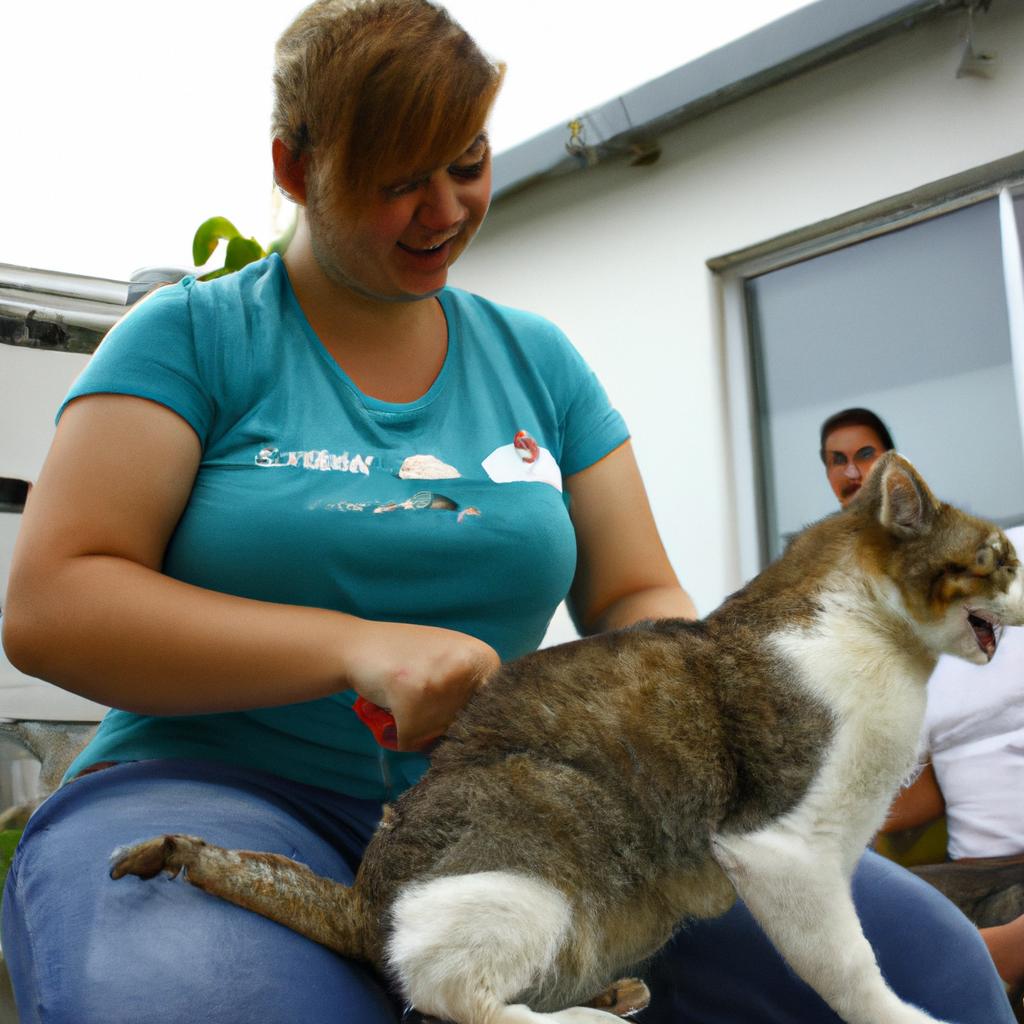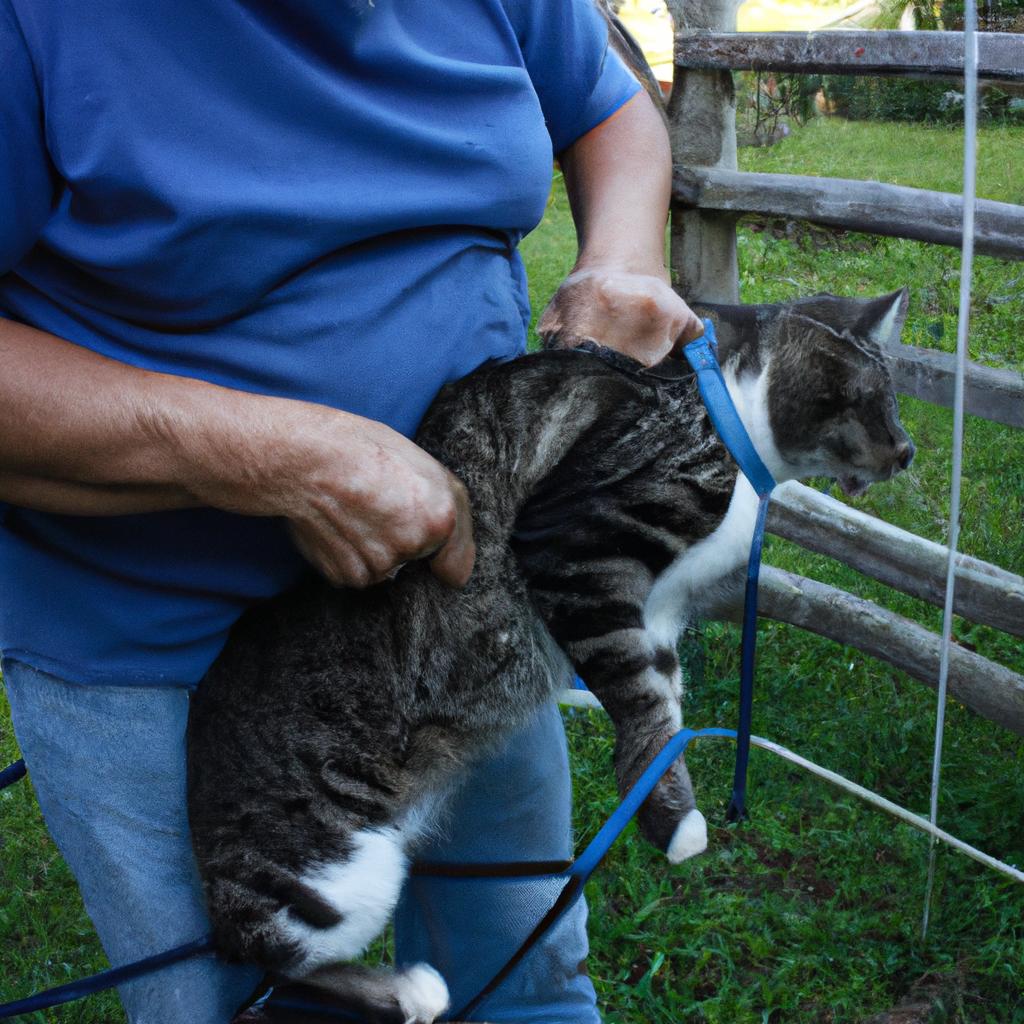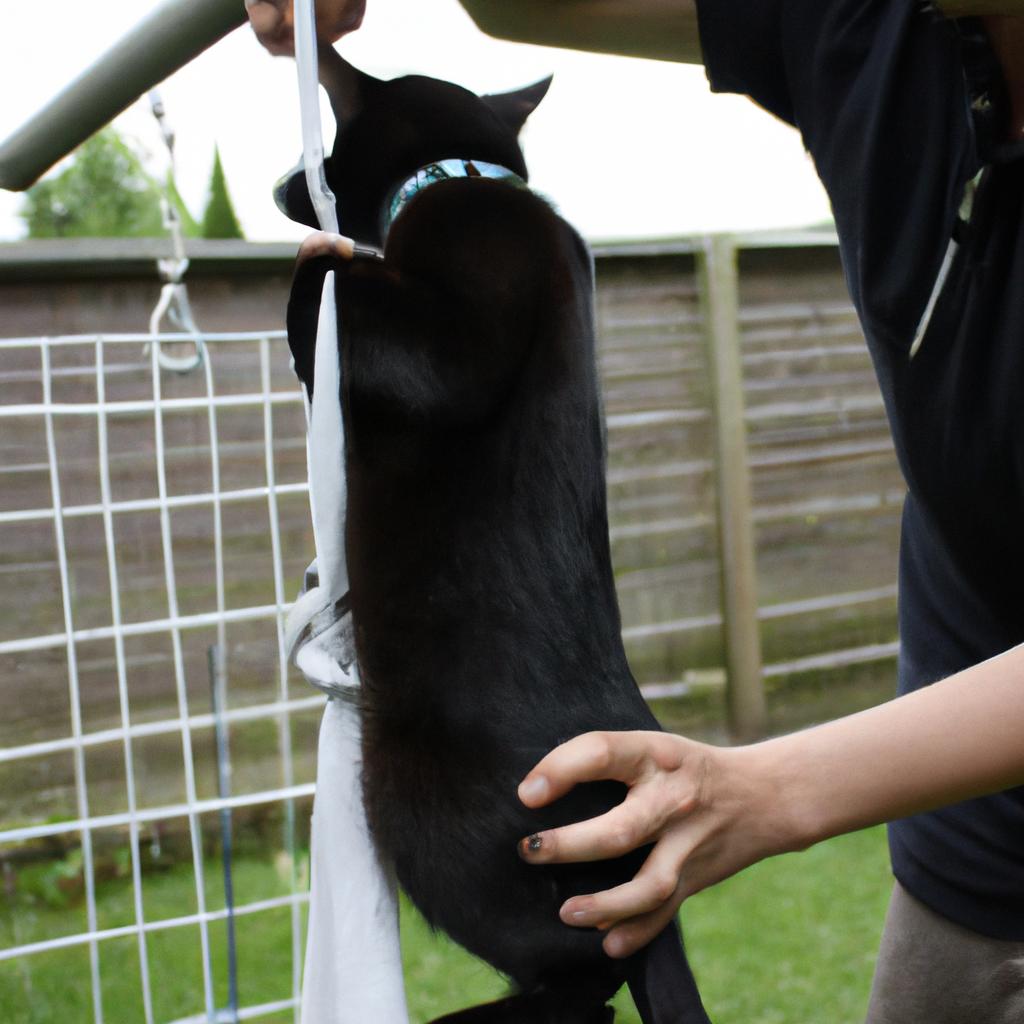Classroom presentations play a crucial role in disseminating knowledge and promoting community education, particularly within the realm of cat rescue. These interactive sessions provide an opportunity for individuals to learn about various aspects of feline care, welfare, and responsible ownership. For instance, imagine a classroom presentation where students are introduced to the case study of a local cat shelter that successfully rehabilitated and rehomed numerous abandoned cats. Through exploring this example, this article will delve into the importance of classroom presentations in raising awareness and equipping communities with essential skills needed to address issues related to stray and neglected felines.
In recent years, there has been an alarming increase in the number of homeless cats across many communities. This surge can be attributed to factors such as abandonment, irresponsible breeding practices, and inadequate understanding regarding proper feline care. Classroom presentations on cat rescue serve as powerful tools for addressing these challenges by providing valuable information on topics like spaying/neutering programs, adoption procedures, and responsible pet guardianship. By employing engaging teaching methods such as multimedia displays, interactive discussions, and hands-on activities, presenters are able to captivate audiences’ attention while imparting practical knowledge.
Moreover, through real-life or hypothetical examples like the aforementioned successful case study at a local cat shelter , students are able to witness the positive impact that cat rescue efforts can have on both individual felines and the community as a whole. By showcasing stories of abandoned cats who were given a second chance at life through rehabilitation and adoption, these presentations help foster empathy and compassion among students. They also highlight the importance of community involvement in addressing the issue of homeless cats.
In addition to raising awareness about stray and neglected felines, classroom presentations on cat rescue also equip individuals with practical skills needed to make a difference. For instance, presenters can educate students on how to recognize signs of neglect or abuse in cats, how to safely approach and handle stray or feral cats, and how to effectively communicate with local animal control agencies or cat rescue organizations. These presentations empower students by providing them with tools and knowledge they can utilize to take action in their own communities.
Furthermore, classroom presentations serve as platforms for collaboration between schools, local cat shelters, and other animal welfare organizations. This partnership enables educators to access valuable resources such as guest speakers from cat rescue organizations who can share their expertise and experiences. It also encourages students to actively engage in volunteer opportunities or fundraising initiatives for local cat shelters.
Overall, classroom presentations on cat rescue play a vital role in raising awareness, fostering empathy, equipping communities with essential skills, and promoting community involvement in addressing the challenges related to stray and neglected felines. Through engaging teaching methods and real-life examples, these presentations have the potential to inspire change-makers who will contribute towards creating a more compassionate society for our feline friends.
Benefits of Classroom Presentations in Cat Rescue
Classroom presentations play a crucial role in raising awareness and educating the community about cat rescue initiatives. By providing valuable information, these presentations not only empower individuals with knowledge but also foster empathy and compassion towards feline welfare. In this section, we will explore the benefits of incorporating classroom presentations into cat rescue programs.
Engagement and Interaction:
One notable benefit of classroom presentations is their ability to engage students actively in learning about cat rescue efforts. For instance, consider a hypothetical case study where a presenter introduces real-life stories of cats that have been successfully rescued from challenging situations. Such narratives capture students’ attention and evoke an emotional response, making the topic more relatable.
Furthermore, incorporating interactive elements like quizzes or group discussions allows for active participation among students. This approach encourages critical thinking and enables them to reflect on the importance of responsible pet ownership and the impact it has on animal welfare.
Empathy Development:
Classroom presentations provide an avenue for fostering empathy towards cats in need of care and protection. To achieve this goal effectively, presenters can utilize various strategies such as bullet points listing key facts highlighting the challenges faced by stray or abandoned cats:
- Overpopulation: Thousands of cats end up homeless due to uncontrolled breeding.
- Neglect: Many cats suffer from neglect, lack proper veterinary care, and experience malnutrition.
- Abuse: Some unfortunate felines endure abuse at the hands of humans.
- Euthanasia: Without intervention, many cats face euthanasia due to overcrowded shelters or limited resources.
By presenting these distressing realities through concise bullet points within classroom materials, educators help create awareness about the plight of these animals while simultaneously evoking empathy among students.
Community Engagement:
Finally, classroom presentations serve as a catalyst for broader community engagement in cat rescue initiatives. These sessions offer opportunities for organizations involved in feline welfare to connect with potential volunteers or supporters who may be interested in making a positive impact. To illustrate this point, the following table showcases three examples of how students and community members can contribute to cat rescue efforts:
| Opportunities for Engagement | Examples |
|---|---|
| Volunteering at local shelters | Assisting with daily care tasks or organizing fundraising events |
| Fostering kittens | Providing temporary homes until they find permanent adoption |
| Advocacy and outreach | Educating others about responsible pet ownership through social media campaigns |
By presenting these avenues for involvement during classroom presentations, individuals are encouraged to actively participate in cat rescue initiatives, fostering a sense of responsibility towards animal welfare.
Transition into “Engaging Students in Cat Rescue Initiatives” section:
In light of the numerous benefits associated with classroom presentations, it is essential to explore ways of engaging students further in cat rescue initiatives. By building on their newfound knowledge and empathy, we can empower them to take concrete steps towards creating a more compassionate society that values feline well-being.
Engaging Students in Cat Rescue Initiatives
Having explored the benefits of classroom presentations in cat rescue, it is crucial to highlight how these initiatives can effectively engage students in understanding the challenges faced by stray cats. By fostering empathy and promoting awareness, these presentations pave the way for meaningful change within local communities.
Engaging Students through Real-Life Stories:
For instance, let’s consider a hypothetical case study involving a group of middle school students who were presented with real-life stories about abandoned kittens found on the streets. The presentation showcased how dedicated volunteers rescued and rehabilitated these vulnerable creatures before finding them loving forever homes. This compelling example allowed students to connect emotionally with the plight of stray cats while also witnessing their journey towards a better life.
Evoking an Emotional Response:
To further evoke an emotional response among students, educators can utilize various strategies during classroom presentations. Here are some effective techniques that can be employed:
- Sharing heartwarming success stories of cats who have been successfully adopted.
- Presenting photographs or videos showcasing the transformational impact of rescue efforts.
- Encouraging interactive discussions where students can express their thoughts and feelings regarding animal welfare.
- Involving local shelters or rescue organizations as guest speakers to provide firsthand accounts of their experiences.
Promoting Awareness through Visuals:
In addition to storytelling, visuals play a pivotal role in creating lasting impressions. A three-column table highlighting key statistics related to stray cats’ population and challenges could serve as a powerful visual aid during classroom presentations. By displaying facts such as the number of stray cats euthanized each year, the importance of spaying/neutering programs, and the role individuals can play in reducing feline homelessness, this table effectively conveys urgent messages while stimulating compassion.
Transition into subsequent section:
By engaging students emotionally and increasing their awareness about the struggles faced by stray cats, classroom presentations create a solid foundation for teaching responsible pet ownership. Through these initiatives, students learn not only about the importance of caring for their own pets but also about making a positive impact on the lives of animals in need.
Teaching Responsible Pet Ownership through Classroom Presentations
Building on the importance of involving students in cat rescue initiatives, classroom presentations serve as a valuable tool for community education. By delivering informative and engaging sessions, educators can empower young individuals to become advocates for feline welfare. To illustrate this point, let us consider an example where a local elementary school invited a representative from a nearby animal shelter to conduct a presentation on responsible pet ownership.
During the classroom presentation, the speaker highlighted various aspects related to cat care and rescue efforts. The session began with an interactive discussion about common misconceptions surrounding cats as low-maintenance pets. This engaged the students immediately, capturing their attention and encouraging active participation throughout the presentation.
To further enhance the impact of classroom presentations in cat rescue education, incorporating emotional appeals can be highly effective. Consider the following bullet points that address both rational and emotional dimensions:
- Educating children about proper litter box maintenance not only ensures cleanliness but also prevents potential health hazards for both cats and humans.
- Teaching empathy towards animals helps foster compassion among students, leading to more responsible actions toward stray or abandoned cats.
- Encouraging adoption over buying supports shelters’ mission to find loving homes for rescued cats while discouraging unethical breeding practices.
- Explaining how sterilization through spaying and neutering reduces overpopulation and euthanasia rates evokes a sense of responsibility among students.
In addition to emotional appeals, visual aids such as tables can further engage students by presenting information in a clear and organized manner. Here is an example utilizing a three-column table format:
| Topic | Facts | Impact |
|---|---|---|
| Stray Cats | Millions roam streets worldwide | Starvation, disease transmission |
| Animal Shelters | Thousands overcrowded | Limited resources |
| Responsible Ownership | Vaccinations required annually | Prevents spread of diseases |
Through these interactive elements, classroom presentations effectively convey the importance of responsible pet ownership and cat rescue initiatives to young learners. By fostering empathy, providing practical knowledge, and highlighting the impact of individual actions, students are encouraged to become actively involved in making a difference in their community.
Transitioning into the subsequent section about “Understanding the Importance of Spaying and Neutering in Cat Rescue,” it becomes evident that educating students on responsible pet ownership is just one step towards creating sustainable change.
Understanding the Importance of Spaying and Neutering in Cat Rescue
Transitioning from the previous section, let us delve into how classroom presentations can effectively educate communities about responsible pet ownership. One such example is a case study of a local elementary school where students were given a presentation on caring for cats and promoting animal welfare.
In order to engage the audience emotionally and make the topic more relatable, it is important to incorporate various elements in these classroom presentations. Here are some key strategies that can be utilized:
- Introduce real-life stories: Sharing heartwarming success stories of rescued cats who found loving homes not only creates an emotional connection with the audience but also highlights the positive impact of responsible pet ownership.
- Utilize visual aids: Incorporating images or videos showcasing both happy and unfortunate scenarios related to cat rescue can help create awareness and empathy among students, encouraging them to become advocates for animal welfare.
- Encourage interactive discussions: Engaging students in open dialogues about their understanding of pet ownership responsibilities allows them to reflect upon their own actions and consider ways they can contribute positively towards cat rescue efforts.
- Provide practical guidelines: Equipping students with tangible tips on feeding, grooming, and providing proper healthcare for cats helps empower them with knowledge that they can share with their families and friends.
To further illustrate this point, let’s take a look at the following table which presents statistics regarding abandoned cats in our community:
| Category | Number |
|---|---|
| Cats surrendered | 500 |
| Stray cats rescued | 300 |
| Adopted by families | 200 |
| Euthanized | 100 |
These figures highlight the urgent need for education on responsible pet ownership. Through targeted classroom presentations, we have the opportunity to significantly reduce the number of abandoned cats while fostering compassion within our communities.
Transitioning smoothly into the subsequent section on “Promoting Volunteerism and Active Involvement in Cat Rescue,” we can encourage students to take their newfound knowledge and turn it into action. By instilling a sense of responsibility, empathy, and understanding through these presentations, we are paving the way for a more compassionate society that values every life, feline or otherwise.
Promoting Volunteerism and Active Involvement in Cat Rescue
Transitioning from understanding the importance of spaying and neutering in cat rescue, it is essential to explore ways to promote volunteerism and active involvement within the community. By encouraging individuals to take an active role in cat rescue efforts, we can make a significant impact on reducing the number of stray cats and improving their overall well-being.
One example that showcases the power of volunteerism is Sarah’s story. Sarah, a passionate animal lover, decided to dedicate her time to volunteering at a local cat shelter after attending a presentation about cat rescue. She began by assisting with daily care tasks such as feeding, cleaning litter boxes, and providing socialization for the cats. Over time, Sarah developed a deep connection with these animals and became actively involved in fundraising events, adoption drives, and educational programs aimed at raising awareness about responsible pet ownership.
To inspire others like Sarah, here are some key strategies that can effectively promote volunteerism and active involvement:
- Organizing community outreach programs: Hosting events such as adoption fairs or information sessions at schools, libraries, or community centers allows people to learn more about cat rescue efforts and how they can get involved.
- Establishing partnerships: Collaborating with local businesses or organizations can help expand outreach efforts. For instance, partnering with veterinary clinics may provide opportunities for discounted spay/neuter services or vaccinations for rescued cats.
- Providing training opportunities: Offering workshops or seminars on topics related to cat behavior, first aid techniques, or fostering skills enables volunteers to enhance their knowledge while feeling empowered to contribute meaningfully.
- Recognizing volunteers’ contributions: Implementing recognition programs that acknowledge volunteers’ dedication fosters a sense of pride and encourages continued engagement.
Table: Benefits of Volunteering in Cat Rescue Efforts
| Benefit | Description |
|---|---|
| Personal fulfillment | Volunteering in cat rescue provides a sense of purpose and joy. |
| Skill development | Volunteers learn valuable skills such as animal care and advocacy. |
| Community connection | Engaging with like-minded individuals fosters a sense of belonging. |
| Positive impact on cats’ lives | Volunteers directly contribute to improving feline well-being. |
By promoting volunteerism and active involvement, we can create a community-driven approach towards cat rescue efforts that goes beyond individual actions. This collaborative spirit sets the foundation for the next section, which focuses on raising awareness about cat overpopulation within the community, thereby addressing this issue at its core.
Raising Awareness about Cat Overpopulation in the Community, it is crucial to understand the factors contributing to this problem and how education plays a vital role in preventing it from escalating further.
Raising Awareness about Cat Overpopulation in the Community
Promoting Volunteerism and Active Involvement in Cat Rescue has proven to be an effective way of raising awareness about the issue. Now, let’s explore another powerful tool for educating the community: Classroom Presentations in Cat Rescue. These presentations play a crucial role in informing individuals about cat rescue efforts, encouraging them to become volunteers, and furthering their understanding of the importance of responsible pet ownership.
To illustrate the impact of classroom presentations, consider this hypothetical case study: A local school invites a representative from a cat rescue organization to speak to students about the challenges faced by stray cats in their community. The presentation includes real-life stories of rescued cats, highlighting both heartwarming success stories and difficult situations that require immediate intervention. By presenting these narratives, students are able to connect emotionally with the subject matter and develop empathy towards cats in need.
The effectiveness of classroom presentations lies not only in storytelling but also in providing practical information on how individuals can contribute positively to cat rescue efforts. Here are some key components commonly included:
- Informative lectures: Presenters offer detailed explanations about various aspects of cat rescue such as trap-neuter-return programs (TNR), fostering opportunities, adoption procedures, and ways to advocate for animal welfare.
- Engaging visuals: Utilizing compelling images or videos showcasing before-and-after transformations helps grab students’ attention and creates lasting impressions.
- Interactive activities: Workshops or demonstrations involving basic training techniques or mock adoption scenarios allow students to actively participate and better understand the responsibilities associated with pet ownership.
- Q&A sessions: Encouraging students’ inquiries fosters open dialogue and allows presenters to address any misconceptions while reinforcing important concepts discussed during the presentation.
Incorporating emotional elements into these presentations is critical for capturing audience interest. To evoke such responses effectively, bullet points like those below may be used:
- Tragic tales of abandoned kittens left vulnerable on the streets
- Heartwarming success stories where rescued cats find forever homes
- The impact of responsible pet ownership on reducing cat overpopulation
- Statistics highlighting the positive outcomes achieved through community involvement
Additionally, a table can be included to illustrate the tangible benefits of volunteering in cat rescue:
| Benefits of Volunteering in Cat Rescue | Emotional Impact | Social Change |
|---|---|---|
| Increased sense of purpose and fulfillment | Empathy towards animals | Reduced stray cat population |
| Opportunities for personal growth | Compassion for fellow humans | Improved animal welfare policies |
| Development of valuable skills | Building a caring community | Strengthened bond with pets |
| Networking with like-minded individuals | Encouraging empathy in others | Promoting responsible pet ownership |
Classroom presentations offer an invaluable platform for educating students and fostering active involvement in cat rescue efforts. By utilizing engaging storytelling techniques, providing practical information, encouraging audience participation, and evoking emotional responses, these presentations have proven to be effective tools in raising awareness about cat rescue initiatives and inspiring compassionate action within communities.




